
Tom Scott Vineyard Newsletter - February 2017 - Barn Burner Cabernet Sauvignon

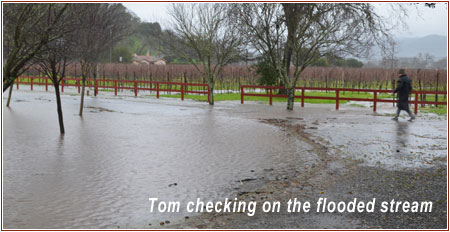 The big question we've been hearing all winter, and from all over the country is "Are the vines okay with all this rain?" The short answer is yes; standing water in the vineyards during the winter, does not affect the vines. While flooded vineyards look very dramatic, being in or even under water does not harm them so long as they are dormant. Cold temperatures in late fall coax the vines into slowing down, reducing their need for oxygen and nutrients. During this dormant period, the vines can stand "wet feet." The big question we've been hearing all winter, and from all over the country is "Are the vines okay with all this rain?" The short answer is yes; standing water in the vineyards during the winter, does not affect the vines. While flooded vineyards look very dramatic, being in or even under water does not harm them so long as they are dormant. Cold temperatures in late fall coax the vines into slowing down, reducing their need for oxygen and nutrients. During this dormant period, the vines can stand "wet feet."
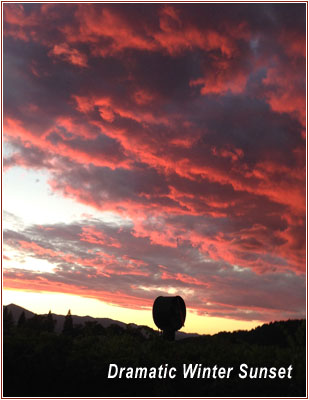 Our vineyards are at "field capacity," which means the ground cannot hold any more water. With the advantage of well-drained soils, our vines have not had a great deal of deep standing water, but the ground is very wet, making it difficult for us to work in the fields. And if the rain continues into late spring, the vine roots might begin to suffocate if they remain in standing water, or in soggy, wet ground. Our vineyards are at "field capacity," which means the ground cannot hold any more water. With the advantage of well-drained soils, our vines have not had a great deal of deep standing water, but the ground is very wet, making it difficult for us to work in the fields. And if the rain continues into late spring, the vine roots might begin to suffocate if they remain in standing water, or in soggy, wet ground.
Now is the time we would like this wonderful rain to stop, or at least to tapper off and let the glorious sun shine! As the days lengthen and warm, the vines will resume growing again. This is when we begin pruning, the most important vineyard operation of the year. It's important that the vines are in growing mode when we prune them. The flowing sap serves to prevent disease from entering with the rain through fresh pruning wounds. We have always started pruning in mid to late February. Delaying pruning slows the vines' development. Also, by pushing off growth until later in the spring, we reduce the chances of spring frosts damaging the tender new shoots.
 This year we are starting our pruning later than we have in the past. The weather has not only been wet, but cold. The vines seem to be waking up slower this year, and not pushing as much as we'd like, causing us to further delay the pruning. Our weather forecast shows at least 10 days of sun coming our way, and we plan to begin pruning as soon as the fields have dried out a little and the air temperatures have warmed up. This year we are starting our pruning later than we have in the past. The weather has not only been wet, but cold. The vines seem to be waking up slower this year, and not pushing as much as we'd like, causing us to further delay the pruning. Our weather forecast shows at least 10 days of sun coming our way, and we plan to begin pruning as soon as the fields have dried out a little and the air temperatures have warmed up.
After five years of drought, the rain is more than welcome. The rain that fell in the fall and winter helped the vine store nutrients over the winter, which is needed to give us healthy and productive spring growth. Vines that have spent the last several years under stress are now going to enjoy a vital burst of nutrients. The root system of a vine is usually as big as the canopy that develops above, and is spread out in an underground circumference around the vine. Drip irrigation allows water to enter at two points, feeding only a small percentage of the root system. This winter's rains have brought nutrients from all over the vineyard, and wet soil will allow the roots to easily take up all that the plant needs.
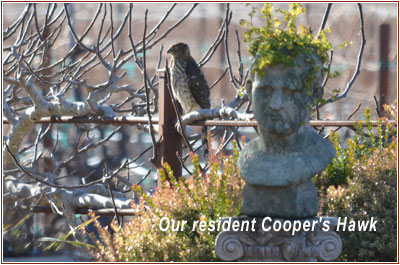 One advantage we may see from the rain that fell in the fall, is a potentially large canopy and crop. The influx of nutrients carried into the field by running water during the winter might well provide a potential boost to the vines' production. Now the important question is when will the rain stop, because late rain can harm the vine crop. Too much rain in early spring when buds have begun to swell can cause the roots to start to suffocate if they are in standing water for too long. Damage can also result if we get rain during bloom, when the vine flowers are ready to be self-pollinated. The rain can knock the flowers off, or interfere with pollination, thus affecting the number of grape clusters and grapes that the vine will produce. This damage is called "shot berry," indicating berries that do not properly develop. If the rain lasts into the summer, we may have problems with mildew in the vineyards. Late rain might also affect the temperature in the vineyard, instigating a cooler than "normal" growing season. It's the warm temperatures that cause the vines to wake up and commence their growing season. If that phase starts too late into the year, the grapes might not have enough growing time to fully ripen. In the cool growing season of 2010, we waited to harvest our fruit until early November, just before the vines went dormant. One advantage we may see from the rain that fell in the fall, is a potentially large canopy and crop. The influx of nutrients carried into the field by running water during the winter might well provide a potential boost to the vines' production. Now the important question is when will the rain stop, because late rain can harm the vine crop. Too much rain in early spring when buds have begun to swell can cause the roots to start to suffocate if they are in standing water for too long. Damage can also result if we get rain during bloom, when the vine flowers are ready to be self-pollinated. The rain can knock the flowers off, or interfere with pollination, thus affecting the number of grape clusters and grapes that the vine will produce. This damage is called "shot berry," indicating berries that do not properly develop. If the rain lasts into the summer, we may have problems with mildew in the vineyards. Late rain might also affect the temperature in the vineyard, instigating a cooler than "normal" growing season. It's the warm temperatures that cause the vines to wake up and commence their growing season. If that phase starts too late into the year, the grapes might not have enough growing time to fully ripen. In the cool growing season of 2010, we waited to harvest our fruit until early November, just before the vines went dormant.
In the vineyard, through our pruning, we are constantly seeking balance. The purpose of pruning is to reduce the number of buds, promoting balance between shoot growth and the number of grape clusters. The growth is vigor, and the clusters represent yield. A well-balanced vine will produce optimum fruit quality when the vine has managed vigor.
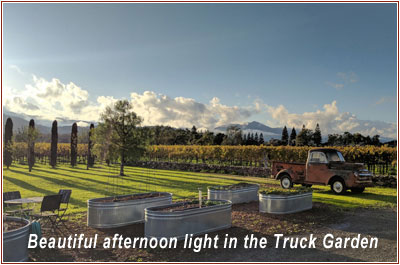 Everything we do in the vineyard is about striking a balance; a well-balanced vineyard is a healthy vineyard. But by now it should be clear that we don't control everything that affects the vineyard or vines. We do our best to work with Mother Nature, but she is clearly running the show. We need her to give us a balanced rainfall, not only how much falls, but even more importantly when it falls. We need her to give us a certain number of warm days to ensure a healthy crop, balanced with cool nights to let the vines rest and be restored during the summer months. Everything we do in the vineyard is about striking a balance; a well-balanced vineyard is a healthy vineyard. But by now it should be clear that we don't control everything that affects the vineyard or vines. We do our best to work with Mother Nature, but she is clearly running the show. We need her to give us a balanced rainfall, not only how much falls, but even more importantly when it falls. We need her to give us a certain number of warm days to ensure a healthy crop, balanced with cool nights to let the vines rest and be restored during the summer months.
This is a partnership. For our part, we promise to show up and pay attention, to be responsive to the needs of the vineyard and land, and to do no harm. We continue to farm sustainably, in an effort to keep both our lives and our livelihood in balance. Mother Nature, in her generosity, keeps us endlessly entertained, challenged and in a constant state of awe. Perfect!
Keep enjoying the wine! 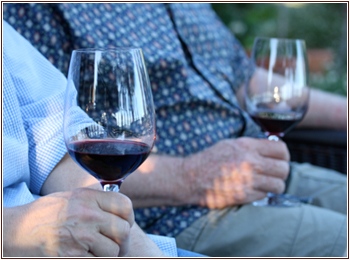
Tom and Lauren Scott
www.tomscottvineyard.com
www.tomscottvineyard.com/wineshop
info@tomscottvineyard.com
Back-issues of our Notes

|



